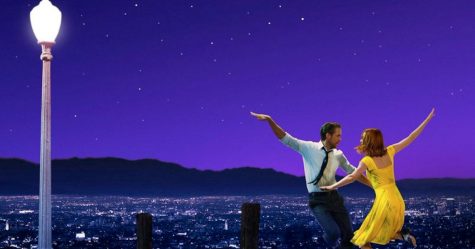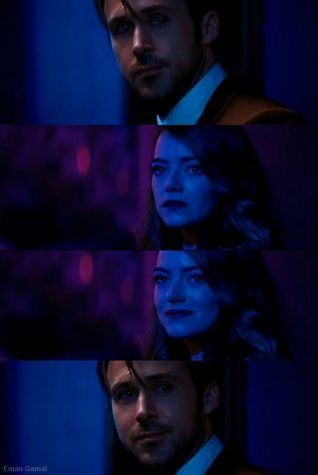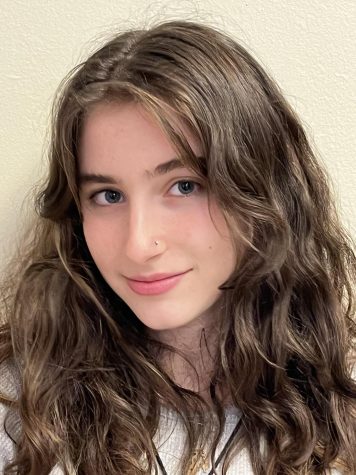Damien Chazelle’s genius: Color analysis of “La La Land” and “Whiplash”
(Spoilers Ahead)
April 15, 2021
One of the most beautiful things Damien Chazelle shows in both “La La Land” and “Whiplash” is his use of saturated colors. Though where “La La Land” is vivid, “Whiplash” is brooding, and when the respective movies deviate from art, the former becomes bleak while the latter becomes brighter, not only does this give the films a beautiful aesthetic not usually seen in movies, but allows the watchers to get into the characters headspace and journey without explicit dialogue.
“La La Land”
This is shown from the very beginning of “La La Land” through primary colors. On the freeway after the opening song, Mia and Sebastian are both seen in white and brown in their cars respectively, while the rest of the dancers are in color blocks, representing their disconnect from the traditional Hollywood glamor (Sebastian’s search for traditional Jazz revival, and Mia’s continual failed auditions). As each one gets pulled slowly into the world (though Mia is the first to dive into life) and meet at one of the initial parties, they are dressed in color.

Mia is yellow, optimistic, perfectionistic, and exciting. Sebastian is red, headstrong, passionate, and proactive. Not only does this bring us into their person, but it shows the current split nature of their relationship. After the party, during “City of Stars” Mia has adopted a red purse (first connection between the pair) and a purple sky blossoms behind their dancing- the color of their relationship and the melding of primary colors.

This color is seen through the rise and fall of their time together. They are cloaked in indigo through their first romantic dance at the planetarium, baby blue during the bittersweet “I will always love you”, and deep purple in the heartbreaking final scene at the jazz club. Every time they share a significant moment or go through a new relationship stage we see a different blue depending on intensity of emotion. The downfall of their relationship is surrounded in green: jealousy, mistrust, a twisted variant of the purple we love.
As they grow apart, they relapse into primary colors- but this time in reverse. As Mia discovers her authentic self throughout Hollywood and performs her one woman play, and into her after-Paris fame she is in white, maker of the genuine art that Sebastian sought to resuscitate. As Sebastian falls into the modern Jazz group and adheres to their norms he transitions into a color block universe and becomes entranced within the artificial world he hated so much. They essentially become each other, and this doesn’t have to be explicitly stated because of the color repetition watchers have been noticing
The color in “La La Land” comes to a head throughout the final fantasy sequence. Though straight out of Mia’s mind, the single color scenes just serve to illustrate how artificial and frozen their relationship is in time, contrasting the convoluted colors of her reality. Their final look is lit with the memory of their time together, and the purple evokes a visceral response that the audience feels so deeply because of the pigmentation through their relationship.

“Whiplash”
A similar use of color is displayed throughout “Whiplash”, “La La Land’s” predecessor. In the opening scene, Chazelle pans in on Andrew practicing the drums in an empty room. He is in a sheer white t-shirt, and through that embodies his purity and naivety of the complex music industry. This is almost instantly contrasted by Fletcher’s appearance in the doorway, all in black, the personification of corruption and hardship that foreshadows the journey Andrew will take throughout the movie. Once he joins the studio band Andrew opts for a blue button up, then a darker blue tee, and excluding the early black performance numbers, he gets darker and darker clothing, until he’s in fletchers original getup in the final scene: a descent into depravity, loss of innocence, and almost a mirror of his mentor. The only times Andrew seems to pause this spiral is when he’s with his -short lived- girlfriend, and when he’s expelled, where he wears flannels, light colors, and different designs. Taking a break from the toxicity of music is lifting his core, but he abandons light for greatness, as reflected within his clothes color.
The use of color is shown not only just through Andrew’s clothes, but the background. When he first interacts with Fletcher, he fails at double time swing. A dark green illuminates the room, showing stagnation (within his playing), a need to prove himself, yet doubly the potential of growth. As Andrew becomes indoctrinated within the studio band and distances himself from his family to sink further within Fletchers grasp, a deep yellow, almost gold, appears and remains constant for a while, hand in hand with his sacrifices to music in the name of greatness. Despite the sacrifices paired with the color, yellow has always been paired with improvement and growth, something abruptly broken when he breaks up with his girlfriend.
 This starts the downward spiral that leads to his expulsion, foreshadowed by the same green in the performance after Andrews car crash as the opening scene: representing the same stench of failure.
This starts the downward spiral that leads to his expulsion, foreshadowed by the same green in the performance after Andrews car crash as the opening scene: representing the same stench of failure.
When he gets expelled, the set whitens along with Andrew’s view of the world as his tunnel vision lifts. It’s refreshing to see, yet bleak and jarring, having adapted to the warmth of the studio. Chazelle makes us re-settle into this regular world, then abruptly yanks the audience into yellow once more. Like “La La Land”, “Whiplash” culminates with this color we’ve grown to yearn for in its absence. Andrew once again falls under Fletcher’s influence, and the hue gets more and more intense until the movie cuts off. The singularity of his passion is so strong to the audience because of the color association that it takes time to realize the intense implications of the last few shots.




